The Preston School
The Preston School
It was founded in 1686 by John Preston.
John Preston came to Dublin from Bolton in Lancashire in the 1650s to see what a loyal Puritan might gain from the Catholic dispossession which occurred in the aftermath of the Rebellion of 1641 and the Cromwellian Confiscations. Preston aquired the Nangle Estate in Navan and many others in Dublin and Leix, totalling around 10,000 acres.
Guessing that many of his defective titles might be questioned in time, he set aside 1000 acres of his gains from the Nangle estates to endow 2 Protestant schools, to be run by "an able schoolmaster of the Protestant religion, to be resident in the town of Navan." (The second school was located in Ballyroan Co. Laois), judging that any government would be reluctant to question the title to land used for such a worthy purpose.
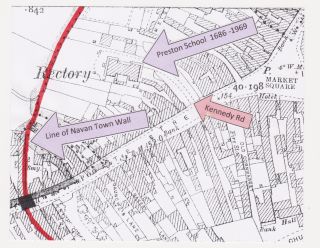 The school was located on a site just off Trimgate St.
The school was located on a site just off Trimgate St.
The first master was Rev. Lyon. For most of its first 150 years in existence the income of the Trust lands went to the schoolmaster who was a friend or relative of the Prestons. For example in 1755, Mr Preston appointed his own brother as schoolmaster, leaving the teaching to underlings. Bishop Lewis Beirne notes "To enquire of Dr. Duigenen as to the legality of giving the endowed school to a person who neither keeps a school nor lives in the house, but employs a deputy."
A report from the Royal Commission in 1784 stated
"...the school at Navan, has been for many years shamefully neglected ... it has appeared to us that the sum of £2348.19.8 of the rents ... has been lost ... the conduct of Mr Jones as receiver of the estate and as law agent, is liable to the charge of mismanagement and neglect in the execution of the duties of both these offices, and that he should no longer continue to be employed by this charity."
In the early 1800s the school had never more than 7 pupils. In 1840, the Royal Commission stated "This endowment represented one of the most remarkable instances of abused trust."
Against the spirit of the Trust, Roman Catholics were sometimes accepted as pupils, although there was a lapse between the 1798 Rebellion and 1815 when the next Catholic pupil entered.
The Preston School was rebuilt in 1829. When the rebuilding was going on, the school moved to Ardbraccan.
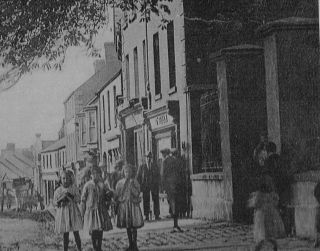
This rather unhappy history continued
until the early 20th century.
In 1918, the number on the roll of the Preston School had increased to 39,
due to the school having a good headmaster
and taking boarders.
In 1969, the Preston School was amalgamated
with Wilson's Hospital School
in Multyfarnham.
(above) The gates to Preston early 20th century.
(courtesy of the National Library of Ireland)
Sources: Rev. Gerard Rice Articles on the History of Navan, Meath Chronicle March 1981
Navan by the Boyne, Noel French 2002
Preston Endowed School Navan, Michael Quane L.L.D. Ríocht na Midhe Vol.1V no 2 1968
Below, taken from a larger photograph c.1960, is a rare image of the Preston School, visible in the centre, and located where Kennedy Rd. is today.
(Note: part of the line of the Navan's town walls is represented by the boundary between the school and the field. Source: Williams 1756 Map of Navan)
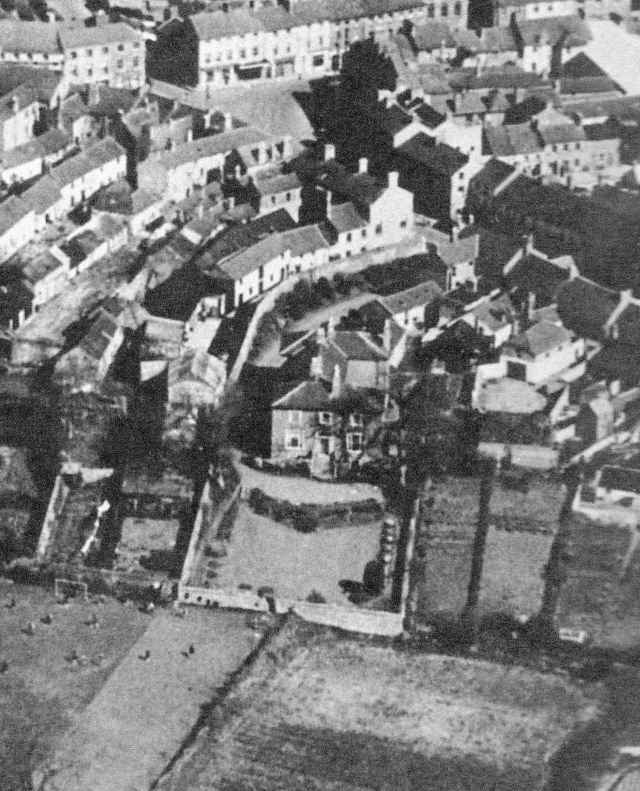
*******
The following vivid description of the Preston School in the 1950s comes from the book Rathcormick - A Childhood Recalled, by Homan Potterton. New Island Books 2001
(Note: Homan Potterton records the names Mr & Mrs Church and Miss Rockingham in the exerpt below. We are reliably informed that these names should be Mr & Mrs Kirk and Miss Cunningham. We are, however preserving the integrity of the text, but noting the discrepancy here.)
"The school was a big old heap of a building hidden away behind formidable gates in the very heart of Navan, with a gravel avenue that approached it from the rear. Its grounds which were all to the front, were large enough for a hockey pitch and several tennis courts to be fitted onto terraces which stepped down, among flower beds here and there, from the main facade.
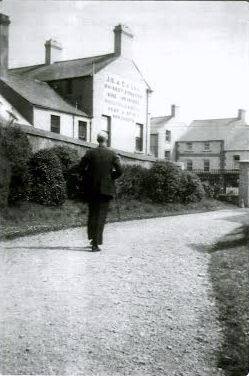
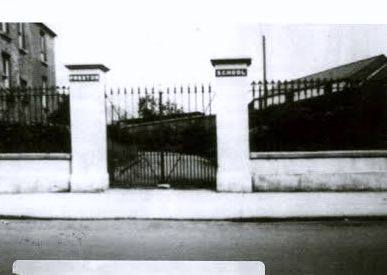
(Left) Mr Kirk, the Principal of Preston School
(known to the pupils as the "Boss")
walking towards the school gates on Trimgate St.
Photo c.1950s
Such was the seclusion of the place, that once inside the precincts it was impossible to imagine or believe that the metropolis which Navan then was buzzed around on every side. The seclusion may have been a key element in the discipline Mr Church succeeded in imposing, as our experience of the outside world was limited to whatever we were able to observe, as we stalked two by two up Flower Hill and out into the country on the extended walks which were an essential element of the school's agenda.
Mr Church along with Mrs Church and her sister Miss Rockingham, lived in the two rooms which overlooked the grounds; the dormitories and classrooms were at the back, the dining hall in the basement. There too was the small yard, enclosed along one side by lavatories, and with the Stick House (where firewood was stored) to the other end. This was the only outside space to which access, unsupervised, was permitted, and it was there on Mondays that lines of navy blue knickers -each bearing the name tags of their owners, were exhibited in the breeze to dry. .. Exceptionally among Irish boarding schools at the time, Preston was coeducational.
(Potterton quotes 12 boys and 16 girls resident in Preston during his time there. )
... Preston's curriculum - English, French, Latin and Irish; algebra, geometry and trigonometry; history and geography were all taught from elementary level to university entrance, and as if that were not astonishing enough, instruction in all these subjects was provided by Mr Kirk himself, with the sole assistance of a kind and gentle Miss Dunbar.
Neither physics nor chemistry was provided for at Preston, nor indeed was Art, but these omissions were offset by the school's reputation for Scripture, while the musical accomplishment of many of the pupils, as well as their capacity for the waltz, gave Preston a renown which far exceeded, in the minds of many of the parents, the attractions and benefits of science.
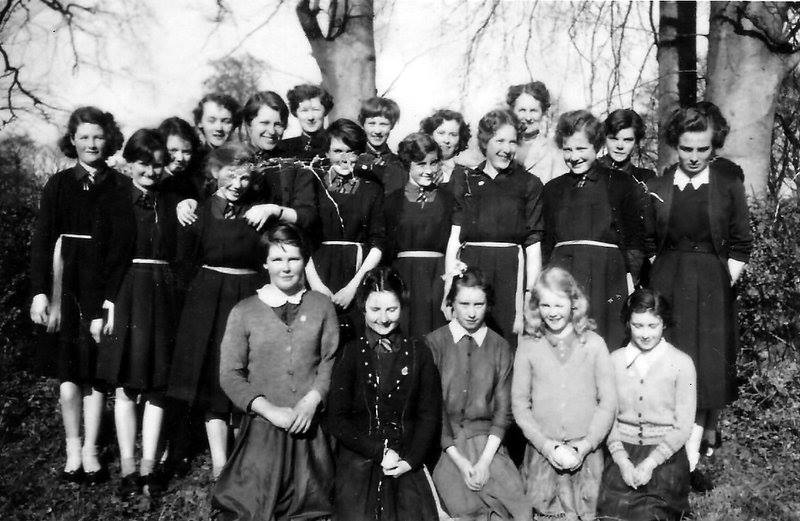
(Above) Preston students 1954-5. We have some, but not all names.
Back Row: 3rd left Jean Henry; 4th left Glennis Symmonds; far right June Hughes.
Middle Row: 2nd left Jennifer McKeever; 4th left Olwyn Onions; 2nd right Linda Tyrrell; 3rd right Mary Tyrrell. (Names thanks to Gerald Williamson)
Miss Rockingham, who had a tenderness and warmth about her personality, was both cook and matron; but beyond all that she was the mother which all of us was missing. She bathed us on Saturday nights, on occasion tucked us into bed, and tended our cuts and sores ... When in the kitchen, she contrived to turn the sparce ingredients which Preston's budget permitted into meals that were sufficiently disguised as to seem like food from home. On Sunday afternoons, she would often emerge - as though a truant herself - to share with us the collapsing remains of a chocolate cake which she had managed to whisk from the trolly while Mr and Mrs Church were enjoying their tea.......
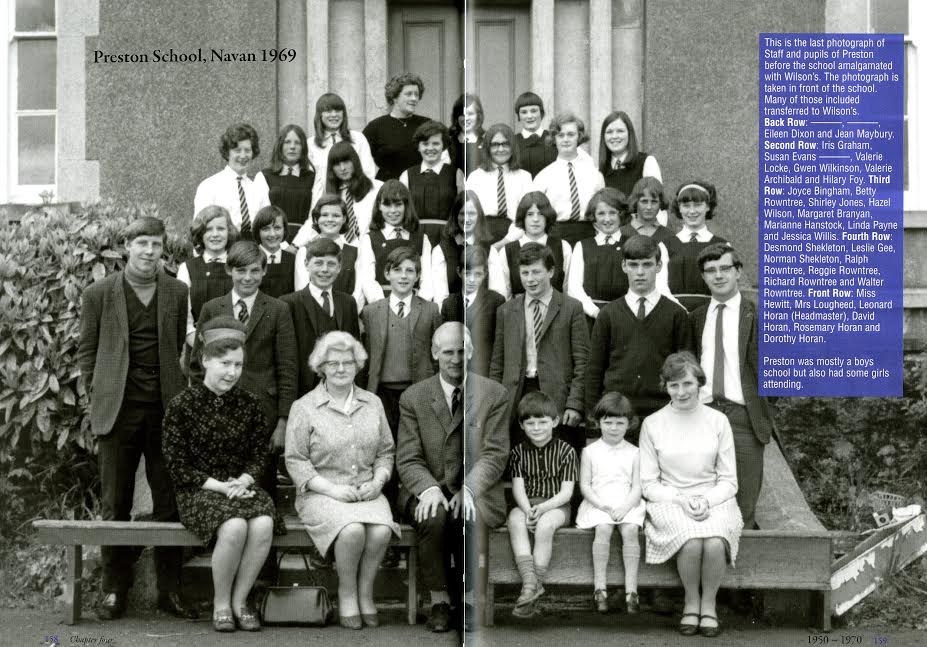
Preston School - teachers and students 1969
... Miss Strong was one of those rare teachers who was so good at teaching that she acted as an inspiration to any pupil with whom she came in contact. She brought the best out of everyone she taught, so that children like myself, who were not in any way gifted musically soon developed a proficiency that was more than reasonable, and within 2 years I had progressed to 2nd grade. On account of Miss Strong, Preston was a musical school; almost everyone learned the piano, and many people were extremely good; the grade examinations of the Royal Irish Academy of Music were part of the annual curriculum, and singing class on Thursdays was one of the highlights of the week...."
See also: Wilson's Hospital Past Pupil's Association http//whsppa.ie
*******
Preston School Navan
‘A Fitting Amalgamation – 1969’
by Liam Coyle, 2012.
Preston School, Navan founded in 1686 by John Preston, was amalgamated with Wilson’s Hospital School in 1969. On the anniversary of the closure of the Navan School, it is an appropriate occasion to remember this unique institution.
The arrival of female students from Preston, Navan to Wilson’s in 1969 would have generated great interest. This is particularly so as the Preston girls were the first girl students to attend Wilson’s. The Preston students arrived with the last Headmaster of their school, Mr. Len Horan, who became Deputy Principal of Wilson’s. The Preston girls are the pioneers for all girl students that have passed through Wilson’s in the forty intervening years.
The philosophy of Preston integrated well with the Wilson’s character. Both schools had similar traditions and outlook. In fact, the Revd. Hill Wilson Whyte who was appointed Warden in Wilson’s in 1879 came from Preston school. The link with Preston is given visible expression in many ways in Wilson’s great assistance through Preston Navan Bursaries assist families financially with school fees. The link is also maintained through the Board of Governor membership from the Navan area. Significantly when a new teaching block was constructed at Wilson’s in 1993 the building was officially named the Preston Building. It is appropriate that in 2009 a fixed corridor linking the Preston building and the Wilson’s building is was constructed symbolising the total integration of the two schools.The spirit of Preston Navan was consistent with that of Wilson’s. This is exemplified in the lines hereafter, written by the former Preston Head Girl Hazel Evans, now Hazel McKeever of Ardee, County Louth. Hazel was a pupil of Preston in the 1940’s, at the same time as the subsequent Chairperson of Wilson’s Hospital School, Mrs Pearl Holt.
Hazel’s words capture best school life in the great Preston School:
Preston School was situated just off the main street in Navan. There was a big iron gate at the entrance and then an avenue leading up to a lovely big house in its own grounds, surrounded by flower beds. At the rear there was a large playing field where we enjoyed hockey, tennis and cricket etc. The school was run by the Kirk family – two maids that came in at 7 a.m. each morning and Lottie who helped rear their three children. Mr. Kirk was a man of many parts: he taught Latin, English and other subjects and also supervised all our games and drove us to all of our hockey matches against either Dundalk, Drogheda or Carrickmacross grammar schools. He also maintained all the grounds which were beautifully kept. I also remember he organised a Christmas concert in which everyone took part – plays and piano recitals (a music teacher) came in once a week etc. It was huge fun for everyone. Another time, they ran a dance for past and present pupils – needless to say we were all kept thoroughly busy. Saturday morning was mending time when we had to darn our socks etc., and Sunday we attended morning and evening service at the church. If it was too cold or wet to play games, we went for a walk – two by two with the poor teacher bringing up the rear!
Mrs. Kirk supervised the domestic side of running the school and her sister, Miss. Cunningham, was matron and a very caring kind one at that. There were two teachers also – one for the junior section and the other taught all the remaining subjects. It was a wonderful school and very well run. It made it possible for many poor Church of Ireland children to obtain a good education. It catered for both day pupils and boarders. The fees were minimal, Mr. Kirk using his own salary to subsidise it. I heard one comment from a father who maintained that he could not keep his daughter at home so cheaply! I was very fortunate to spend six of my happiest years in Preston School and was able to reach Leaving Certificate standard – which we had to sit for at the Loreto Convent. It was sad to see it closed and a big shopping centre in its place now. But the school is fortunate to now be part of Wilson’s Hospital, where it offers many more facilities than would have been possible if it had remained on its own.
*******
Riocht na Midhe, 2015
Wilson’s Hospital School, Multyfarnham- Christopher McCormack page 88.
The amalgamation of Preston is well covered.